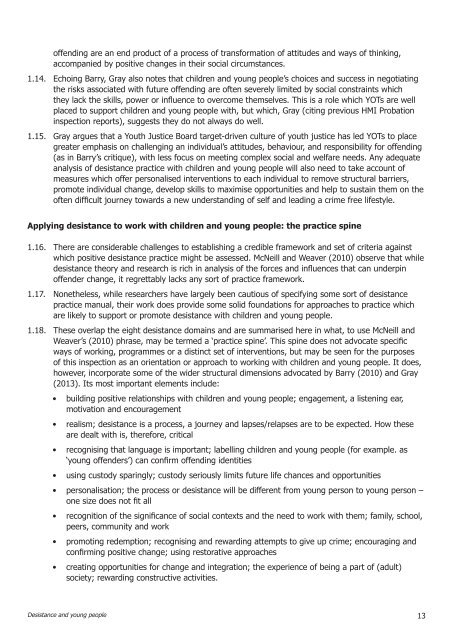Desistance and young people
Desistance_and_young_people
Desistance_and_young_people
You also want an ePaper? Increase the reach of your titles
YUMPU automatically turns print PDFs into web optimized ePapers that Google loves.
offending are an end product of a process of transformation of attitudes <strong>and</strong> ways of thinking,<br />
accompanied by positive changes in their social circumstances.<br />
1.14. Echoing Barry, Gray also notes that children <strong>and</strong> <strong>young</strong> <strong>people</strong>’s choices <strong>and</strong> success in negotiating<br />
the risks associated with future offending are often severely limited by social constraints which<br />
they lack the skills, power or influence to overcome themselves. This is a role which YOTs are well<br />
placed to support children <strong>and</strong> <strong>young</strong> <strong>people</strong> with, but which, Gray (citing previous HMI Probation<br />
inspection reports), suggests they do not always do well.<br />
1.15. Gray argues that a Youth Justice Board target-driven culture of youth justice has led YOTs to place<br />
greater emphasis on challenging an individual’s attitudes, behaviour, <strong>and</strong> responsibility for offending<br />
(as in Barry’s critique), with less focus on meeting complex social <strong>and</strong> welfare needs. Any adequate<br />
analysis of desistance practice with children <strong>and</strong> <strong>young</strong> <strong>people</strong> will also need to take account of<br />
measures which offer personalised interventions to each individual to remove structural barriers,<br />
promote individual change, develop skills to maximise opportunities <strong>and</strong> help to sustain them on the<br />
often difficult journey towards a new underst<strong>and</strong>ing of self <strong>and</strong> leading a crime free lifestyle.<br />
Applying desistance to work with children <strong>and</strong> <strong>young</strong> <strong>people</strong>: the practice spine<br />
1.16. There are considerable challenges to establishing a credible framework <strong>and</strong> set of criteria against<br />
which positive desistance practice might be assessed. McNeill <strong>and</strong> Weaver (2010) observe that while<br />
desistance theory <strong>and</strong> research is rich in analysis of the forces <strong>and</strong> influences that can underpin<br />
offender change, it regrettably lacks any sort of practice framework.<br />
1.17. Nonetheless, while researchers have largely been cautious of specifying some sort of desistance<br />
practice manual, their work does provide some solid foundations for approaches to practice which<br />
are likely to support or promote desistance with children <strong>and</strong> <strong>young</strong> <strong>people</strong>.<br />
1.18. These overlap the eight desistance domains <strong>and</strong> are summarised here in what, to use McNeill <strong>and</strong><br />
Weaver’s (2010) phrase, may be termed a ‘practice spine’. This spine does not advocate specific<br />
ways of working, programmes or a distinct set of interventions, but may be seen for the purposes<br />
of this inspection as an orientation or approach to working with children <strong>and</strong> <strong>young</strong> <strong>people</strong>. It does,<br />
however, incorporate some of the wider structural dimensions advocated by Barry (2010) <strong>and</strong> Gray<br />
(2013). Its most important elements include:<br />
• building positive relationships with children <strong>and</strong> <strong>young</strong> <strong>people</strong>; engagement, a listening ear,<br />
motivation <strong>and</strong> encouragement<br />
• realism; desistance is a process, a journey <strong>and</strong> lapses/relapses are to be expected. How these<br />
are dealt with is, therefore, critical<br />
• recognising that language is important; labelling children <strong>and</strong> <strong>young</strong> <strong>people</strong> (for example. as<br />
‘<strong>young</strong> offenders’) can confirm offending identities<br />
• using custody sparingly; custody seriously limits future life chances <strong>and</strong> opportunities<br />
• personalisation; the process or desistance will be different from <strong>young</strong> person to <strong>young</strong> person –<br />
one size does not fit all<br />
• recognition of the significance of social contexts <strong>and</strong> the need to work with them; family, school,<br />
peers, community <strong>and</strong> work<br />
• promoting redemption; recognising <strong>and</strong> rewarding attempts to give up crime; encouraging <strong>and</strong><br />
confirming positive change; using restorative approaches<br />
• creating opportunities for change <strong>and</strong> integration; the experience of being a part of (adult)<br />
society; rewarding constructive activities.<br />
<strong>Desistance</strong> <strong>and</strong> <strong>young</strong> <strong>people</strong><br />
13


